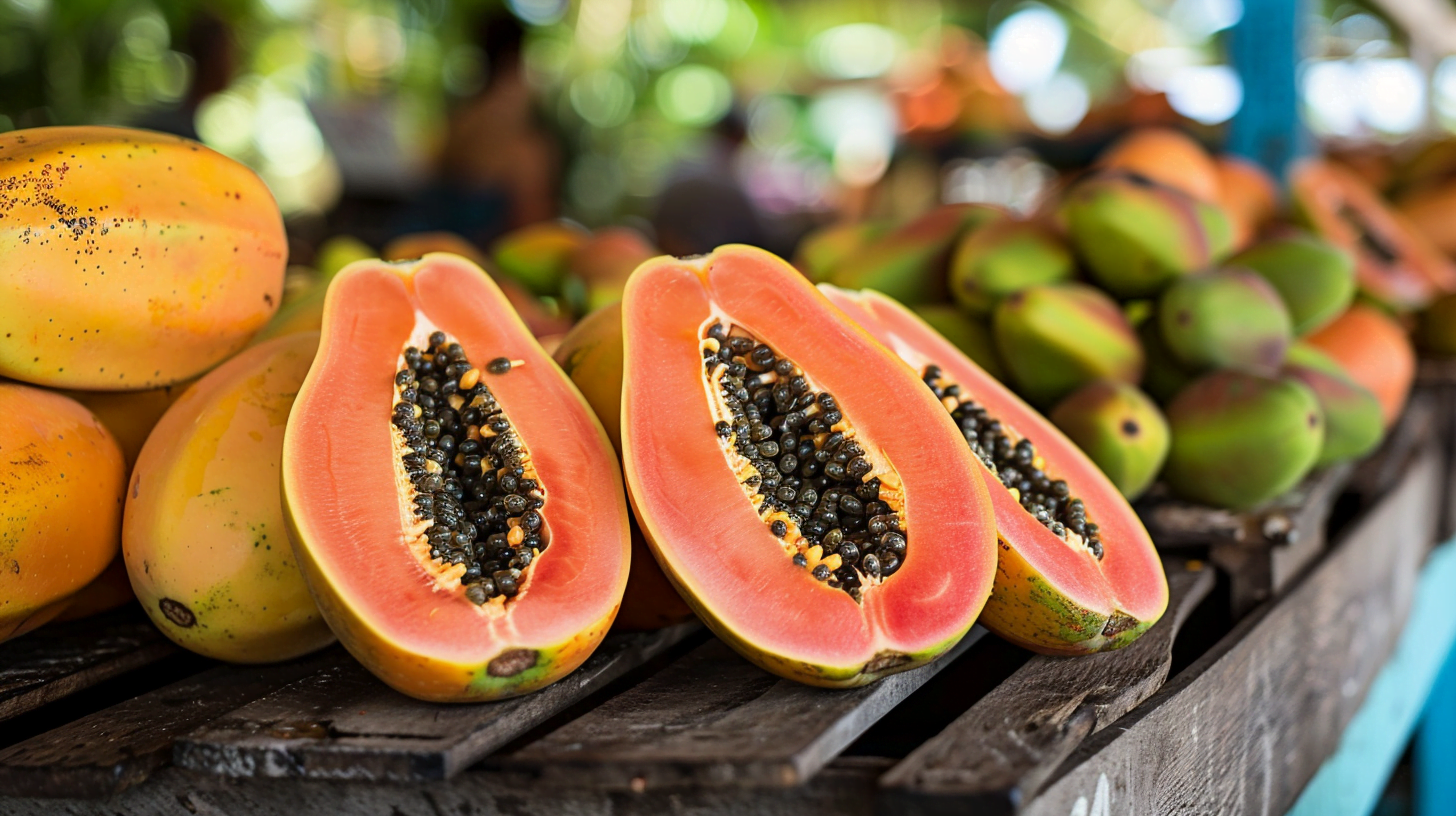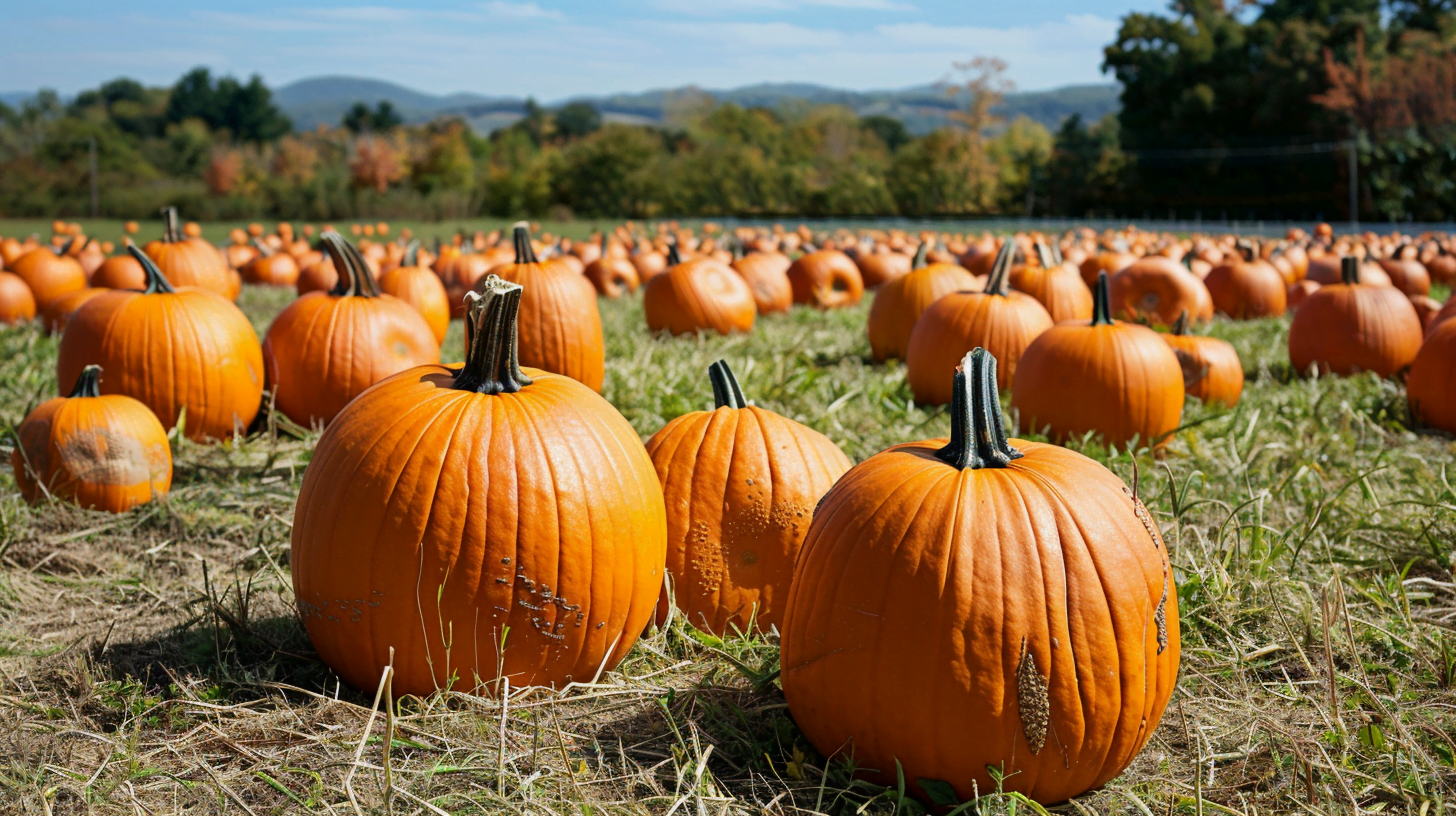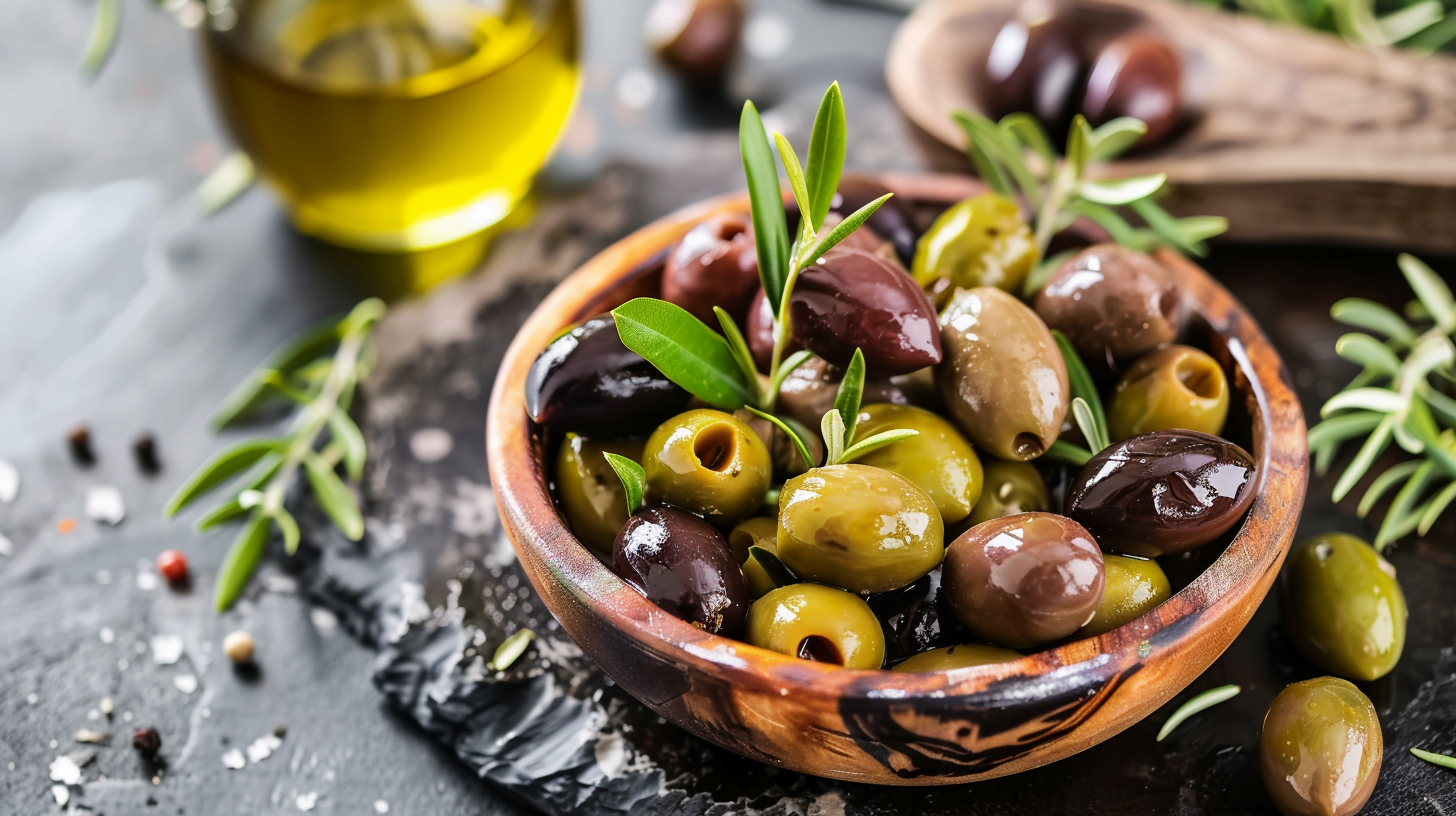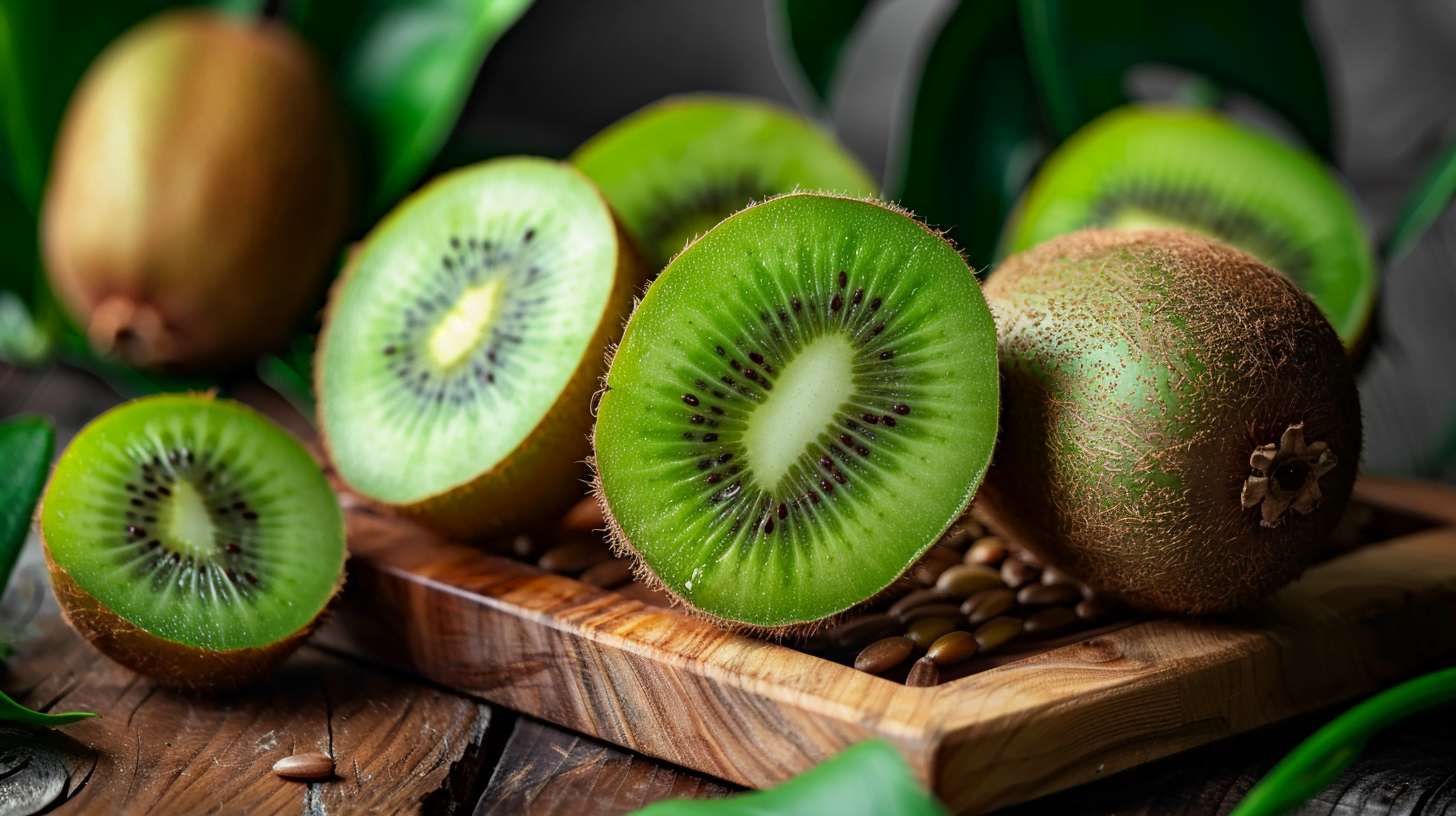Papayas are a delicious and nutritious tropical fruit enjoyed around the world. Known for their sweet taste, vibrant orange flesh, and abundance of vitamins and antioxidants, papayas are a nutritional powerhouse. But when it comes to global production, some countries harvest far more papayas than others. But which country produces the most Papayas?
Overview of Top Papaya Producing Countries
Here are the top five papaya producing countries and their annual production totals, according to 2019 Food and Agriculture Organization data:
- India – 6,449,000 tonnes
- Brazil – 1,980,116 tonnes
- Nigeria – 1,100,000 tonnes
- Indonesia – 822,426 tonnes
- Mexico – 725,240 tonnes
Other major producers include Thailand, Ethiopia, Peru, Venezuela, and the Philippines. But India far surpasses every other nation.
India’s Massive Papaya Industry
India is the world’s largest producer of papayas by a significant margin. Here are some key facts about India’s immense papaya production:
- Annual Production: 6.45 million metric tonnes per year, over 3 times more than 2nd ranked Brazil.
- Major Growing Regions: Andhra Pradesh, Maharashtra, Karnataka, Gujarat, Odisha are the top papaya producing states in India.
- Andhra Pradesh leads all states with annual production of around 1.7 million tonnes. Major districts are Chittor, Kadapa and Kurnool.
- Maharashtra produces over 1.5 million tonnes per year. Key areas are Pune, Ahmednagar, Solapur.
- Karnataka’s annual output is approximately 860,000 tonnes. Major districts are Kolar, Tumkur, Hassan.
- Gujarat produces over 700,000 tonnes/year. Main districts are Surat, Valsad, and Navsari.
- Odisha yields around 450,000 tonnes annually. Cuttack, Puri, and Dhenkanal are important areas.
- Yield: India has the highest productivity rate at around 40 tonnes per hectare, over 20% higher than Brazil. Intensive farming methods and high-yield varieties account for the impressive productivity.
- Exports: India exports papayas to many countries including UAE, Bangladesh, UK, Malaysia, and Sri Lanka. In 2020, India exported 235,290 tonnes of papayas.
Several factors contribute to India’s massive papaya production:
- Tropical climate – India’s warm, humid climate with average temperatures between 21-33°C provides ideal conditions for papaya cultivation across multiple states.
- Abundant arable land – Large tracts of cultivable land across several states like Andhra Pradesh, Maharashtra, and Karnataka are devoted to papaya farming.
- Government support – The government provides various incentives like subsidies for saplings, fertilizers, pesticides and irrigation to boost production. State governments also promote papaya farming.
- Improved practices – Widespread adoption of modern techniques like drip irrigation for water efficiency, integrated pest management to control diseases, and use of high-yield hybrid varieties developed specifically for India have significantly increased yields across the country.
- Increasing demand – Rising domestic demand from a growing population along with export demand makes papaya farming profitable and encourages farmers to expand production.
Papaya Production in Brazil
Brazil is the world’s number two papaya producer. Here are some details on Brazil’s thriving papaya industry:
- Annual Production: Nearly 2 million tonnes per year
- Major Regions: Papaya farming is located mainly in the southeastern states. Espirito Santo is the largest producing state, followed by Bahia.
- Yield: Brazil’s productivity is around 32 tonnes/hectare, about 20% lower than India due to less intensive cultivation.
- Exports: Brazil exports about 10% of its papaya production, mainly to the European Union, USA, Argentina and Canada.
- Growing conditions: Like India, Brazil’s tropical climate and ample farming land allow it to produce millions of tonnes of papayas each year. Temperatures averaging 25°C and evenly distributed rainfall provide optimal growing conditions across Brazil’s southeast region.
- Challenges: Diseases like black spot fungus and powdery mildew can damage yields. Lack of labour in rural areas also makes harvesting more difficult.
Brazil’s plentiful and sweet papayas are consumed locally and exported to various global markets. The abundant fruit provides an important source of revenue for Brazil’s farmers and economy.
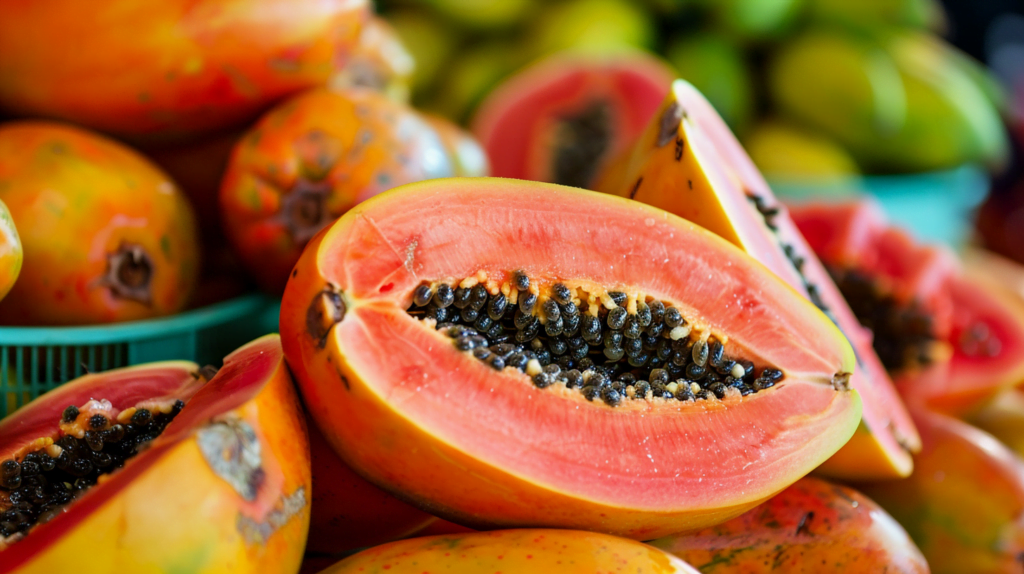
Nigeria’s Expanding Papaya Production
Nigeria is Africa’s largest producer and the world’s 3rd highest papaya producer:
- Annual Production: Approximately 1.1 million tonnes/year
- Major Regions: Production is centered in the southern and middle belt states of Oyo, Ogun, Osun, Kwara, Kaduna, and the Federal Capital Territory.
- Exports: Nigeria exports some dried and processed papaya products regionally to other African countries.
- Outlook: With only 3% of suitable land currently utilized for papaya farming, Nigeria has potential to drastically increase production. The government aims to expand cultivated area to 100,000 hectares by 2025.
Some factors aiding growth of Nigeria’s papaya sector:
- Favorable climate – Nigeria’s warm, tropical climate enables farmers across the southern and middle belt states to grow papayas year-round.
- Government incentives – The Ministry of Agriculture provides subsidies for seeds, fertilizer, equipment and encourages farmers to plant more papayas through extension programs.
- Rising demand – With a population over 200 million and rapid urbanization, demand for papayas in Nigeria is robust and increasing, incentivizing greater production.
If Nigeria can access better storage and processing facilities, and implement solutions to reduce post-harvest losses, the country could likely double or even triple papaya output to become a top global exporter.
Other Major Papaya Producers
Several other countries have sizeable papaya industries:
Indonesia
- Annual production: over 800,000 tonnes, 3rd highest globally
- Main region: Java island which offers ideal climate and land for papaya cultivation
- Exports about 25% of production to regional neighbors
Mexico
- Annual production: around 725,000 tonnes/year
- Major growing areas: Veracruz, Oaxaca, Chiapas, Yucatan, Jalisco
- Exports about 20% of papayas, mostly to the United States
Thailand
- Produces 551,000 tonnes annually
- Key regions: Samut Songkhram, Ratchaburi, Nakhon Pathom
- Major exporter of fresh and processed papayas
Philippines
- Output of 449,000 tonnes/year
- Production centered in Mindanao Region which offers ideal tropical climate
- Exports around 10% of production
Colombia
- Annual production over 380,000 tonnes/year
- Leading department is Huila
- Supplies papayas locally and exports to Central America/Caribbean
Vietnam
- Ranks 7th globally with around 375,000 tonnes/year
- Key growing areas are Tây Ninh and Ðồng Tháp provinces in the Mekong Delta
- Rising exports to China and other Asian markets
Global Consumption Trends
In addition to examining production trends, it’s also worth analyzing the key export markets and consumption trends for papayas:
- United States – The largest importer of papayas. Imports from Mexico and Brazil supply most U.S. demand. Annual consumption around 140,000 tonnes.
- European Union – The EU bloc imports approximately 70,000 tonnes/year from Brazil and other Latin American nations. Spain and Netherlands lead in imports.
- China – With rising incomes and health consciousness, China’s papaya appetite has grown substantially. China imports about 60,000 tonnes annually from Vietnam, Thailand, Philippines. Domestic output also rising.
- Canada – Imports 50,000 tonnes per year, mostly from Mexico. Supplies robust demand from Canada’s immigrant communities.
- Japan – Imports around 35,000 tonnes/year from Taiwan, Philippines, and other Asian sources to meet local demand. Also has some domestic production.
- Russia – Growing importer averaging around 25,000 tonnes/year supplied by Ecuador, Vietnam, and other exporters.
- UAE – Imports increased sharply to meet demand from large expatriate population. Sources include India, Ecuador, Philippines.
Clearly the appetite for papayas globally continues to expand. Diseases and climate change pose challenges for major producers like India and Brazil to maintain exports. But ongoing research into new resilient hybrids provides optimism that output can keep pace with global demand.
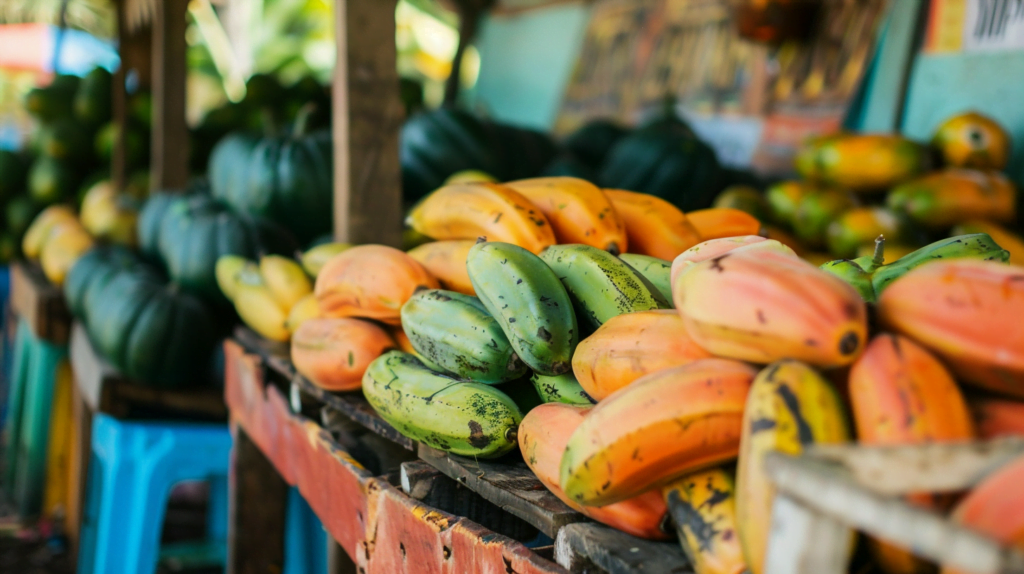
Papaya Diseases – Ongoing Threats & Solutions
Since papayas are vulnerable to various fungal and viral diseases, especially in warm humid climates, producers must vigilantly manage these threats to avoid major crop losses. Here is an overview of the most problematic diseases and some solutions:
Papaya Ringspot Virus
- Most devastating disease that severely impacts yields
- Characterized by distinctive ringspots on fruit and leaves
- Spread by aphids and infected seeds and cuttings
- Genetically engineered PRSV-resistant papaya varieties like Rainbow and SunUp developed to combat it
Powdery Mildew
- Fungal disease favored by moderate temps and humidity
- Coats young leaves, petioles and fruit with white powdery growth
- Reduces vigor and yield if uncontrolled
- Applying fungicides or planting resistant varieties helps protect crops
Black Spot
- Fungal disease that forms dark brown to black spots on leaves and fruits
- Most severe in warm, moist conditions with rain splash dispersal
- Applying appropriate fungicides offers good control
Anthracnose
- Fungal infection that creates dark, sunken lesions on ripening fruit
- Thrives in wet environments with frequent rainfall
- Post-harvest treatment of fruit helps limit losses
Stem End Rot
- Fungal disease which infects papaya stems and fruit after harvest
- Proper post-harvest handling and storage essential for prevention
- Applying fungicides and bagging fruit effective for control
Bacterial Canker
- Bacterial infection that impacts stems and leaves
- Warm, rainy weather promotes spread
- Prevented by using disease-free seeds and controlling aphids and other insects
Phytophthora Blight
- Soilborne fungal disease that causes root rot and discolored stems
- Worst in flooded or poorly drained fields
- Improving soil drainage and applying fungicidal drenches helps protect plants
In summary, viral and fungal diseases present an ongoing battle for papaya farmers. But through developing disease-resistant varieties, implementing integrated pest management techniques, using proper post-harvest handling, and employing other innovative solutions, the industry continues working to minimize losses and sustain bountiful yields.
The Future of Global Papaya Production
Papayas will likely remain a beloved and nutritious tropical staple for years to come. Here is a look at the future outlook for the worldwide papaya industry:
Rising global demand – With an expanding world population and recognition of papaya’s health benefits, demand is projected to increase, especially in Asia, the Middle East, and other emerging markets.
Increased production capacity – Top producers like India, Brazil, and Mexico are expected to maintain growth through higher-yield varieties and expanded acreage. Nigeria and other countries have potential to dramatically increase production if infrastructure improves.
Disease resistance research – Developing papaya varieties with durable viral and fungal disease resistance will be key for sustaining yields. Biotech approaches may help accelerate resistance breeding.
Climate change effects – Rising temperatures and extreme weather events could pressure yields in tropical regions. Adaptive strategies and more climate-resilient varieties will be needed.
Improved post-harvest – Better storage, transport and processing solutions can reduce food loss and waste. Processing into juices, dried fruit, and other value-added products can boost utilization.
Genomic advances – Next generation sequencing and precision breeding tools can help enhance productivity and flavor. Early screening for desired traits will accelerate development of elite cultivars.
In closing, India will likely maintain dominance as the top global papaya producer for the foreseeable future. But ample opportunities exist for other countries to boost yields through advanced agronomic practices and improved papaya varieties better equipped to manage prevalent diseases and climate change pressures. Ultimately, the future looks bright for meeting the world’s growing desire for this nutritious and refreshing fruit.
Conclusion
In summary, papayas are a popular and nutritious fruit cultivated in tropical regions worldwide. When it comes to global production, India is by far the leading country, harvesting over 6 million metric tons per year – more than triple the output of second-place Brazil.
India’s massive production is enabled by an ideal climate, abundant arable land, government support, and widespread adoption of high-yield disease-resistant varieties. Other major producers include Brazil, Nigeria, Indonesia, Mexico, and Thailand, which each harvest hundreds of thousands to millions of tons annually.
However, viral diseases like ringspot virus remain a threat that requires ongoing vigilance. Research into disease-resistant cultivars provides hope for addressing this challenge. As demand increases globally, particularly in markets like the U.S., EU, China, and the Middle East, major producers will need to sustain yields through resilient papaya varieties, improved farming techniques, and advanced post-harvest handling.
If countries can overcome pressures from climate change and crop diseases, the future bodes well for meeting the rising global appetite for sweet, nutritious papayas. While India will likely maintain dominance, sizable production gains across other tropical regions could be achieved to satisfy demands of new consumers worldwide.
